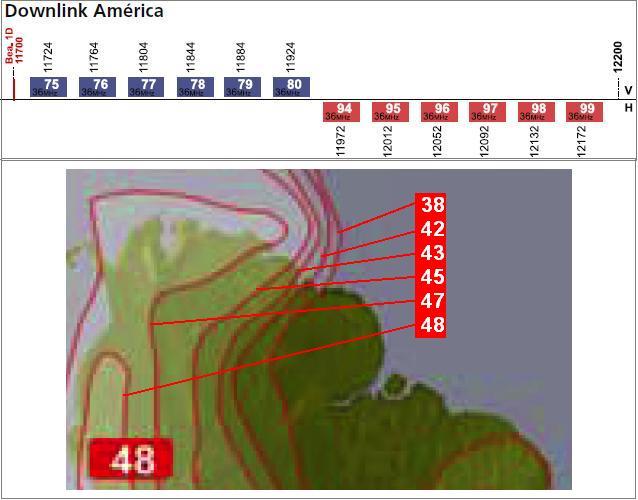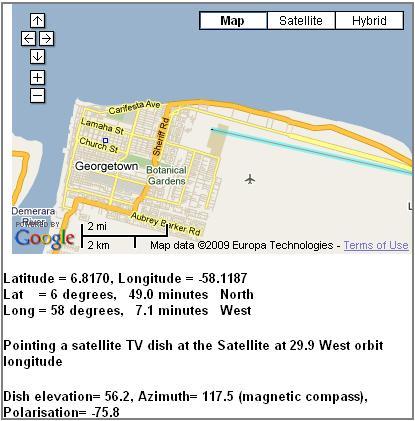| Home Login Register |
| Satellite Internet forum › Dish pointing and alignment › I-Direct Installation: Guyana |
|
Pages: 1
|
I-Direct Installation: Guyana(Read 19340 times) |
|
imon
Member
★★ Offline Posts: 33 Guyana, SA |
Oct 18th, 2009 at 3:43pm
|
| Back to top |
« Last Edit: Oct 22nd, 2009 at 12:06pm by Admin1 »
Keeron Stephens&&IMON Wireless Solutions
IP Logged
|
|
USN - Retired
YaBB Moderator
★★★★★ Offline Posts: 837 Kentucky (USA) |
Reply #1 - Oct 18th, 2009 at 5:22pm
|
| Back to top |
USN (Ret)
IP Logged
|
|
Eric Johnston
Senior Member
★★★ Offline Posts: 2109 |
Reply #2 - Oct 19th, 2009 at 9:40am
|
| Back to top |
IP Logged
|
|
imon
Member
★★ Offline Posts: 33 Guyana, SA |
Reply #3 - Oct 19th, 2009 at 6:18pm
|
| Back to top |
Keeron Stephens&&IMON Wireless Solutions
IP Logged
|
|
USN - Retired
YaBB Moderator
★★★★★ Offline Posts: 837 Kentucky (USA) |
Reply #4 - Oct 19th, 2009 at 6:33pm
|
| Back to top |
USN (Ret)
IP Logged
|
|
Eric Johnston
Senior Member
★★★ Offline Posts: 2109 |
Reply #5 - Oct 19th, 2009 at 6:45pm
|
| Back to top |
« Last Edit: Apr 30th, 2020 at 2:06pm by Admin1 »
IP Logged
|
|
imon
Member
★★ Offline Posts: 33 Guyana, SA |
Reply #6 - Oct 19th, 2009 at 7:47pm
|
| Back to top |
« Last Edit: Oct 19th, 2009 at 10:07pm by Admin1 »
Keeron Stephens&&IMON Wireless Solutions
IP Logged
|
|
Admin1
YaBB Admin
★★★★★ Offline Posts: 1215 |
Reply #7 - Oct 19th, 2009 at 11:02pm
|
| Back to top |
« Last Edit: Apr 30th, 2020 at 2:06pm by Admin1 »
IP Logged
|
|
imon
Member
★★ Offline Posts: 33 Guyana, SA |
Reply #8 - Oct 20th, 2009 at 4:00pm
|
| Back to top |
Keeron Stephens&&IMON Wireless Solutions
IP Logged
|
|
Eric Johnston
Senior Member
★★★ Offline Posts: 2109 |
Reply #9 - Oct 20th, 2009 at 5:21pm
|
| Back to top |
« Last Edit: Apr 30th, 2020 at 2:06pm by Admin1 »
IP Logged
|
|
imon
Member
★★ Offline Posts: 33 Guyana, SA |
Reply #10 - Oct 20th, 2009 at 11:35pm
|
| Back to top |
Keeron Stephens&&IMON Wireless Solutions
IP Logged
|
|
USN - Retired
YaBB Moderator
★★★★★ Offline Posts: 837 Kentucky (USA) |
Reply #11 - Oct 21st, 2009 at 12:38am
|
| Back to top |
USN (Ret)
IP Logged
|
|
Eric Johnston
Senior Member
★★★ Offline Posts: 2109 |
Reply #12 - Oct 21st, 2009 at 8:20am
|
| Back to top |
« Last Edit: Apr 30th, 2020 at 2:13pm by Admin1 »
IP Logged
|
|
imon
Member
★★ Offline Posts: 33 Guyana, SA |
Reply #13 - Oct 26th, 2009 at 1:33pm
|
| Back to top |
Keeron Stephens&&IMON Wireless Solutions
IP Logged
|
|
USN - Retired
YaBB Moderator
★★★★★ Offline Posts: 837 Kentucky (USA) |
Reply #14 - Oct 26th, 2009 at 3:11pm
|
| Back to top |
« Last Edit: Oct 26th, 2009 at 4:28pm by USN - Retired »
USN (Ret)
IP Logged
|
|
Eric Johnston
Senior Member
★★★ Offline Posts: 2109 |
Reply #15 - Oct 26th, 2009 at 3:11pm
|
| Back to top |
IP Logged
|
|
imon
Member
★★ Offline Posts: 33 Guyana, SA |
Reply #16 - Oct 27th, 2009 at 1:26pm
|
| Back to top |
Keeron Stephens&&IMON Wireless Solutions
IP Logged
|
|
imon
Member
★★ Offline Posts: 33 Guyana, SA |
Reply #17 - Oct 27th, 2009 at 8:20pm
|
| Back to top |
Keeron Stephens&&IMON Wireless Solutions
IP Logged
|
|
imon
Member
★★ Offline Posts: 33 Guyana, SA |
Reply #18 - Nov 6th, 2009 at 12:32pm
|
| Back to top |
Keeron Stephens&&IMON Wireless Solutions
IP Logged
|
|
Eric Johnston
Senior Member
★★★ Offline Posts: 2109 |
Reply #19 - Nov 6th, 2009 at 1:13pm
|
| Back to top |
« Last Edit: Apr 30th, 2020 at 2:07pm by Admin1 »
IP Logged
|
|
imon
Member
★★ Offline Posts: 33 Guyana, SA |
Reply #20 - Nov 6th, 2009 at 2:15pm
|
| Back to top |
Keeron Stephens&&IMON Wireless Solutions
IP Logged
|
|
imon
Member
★★ Offline Posts: 33 Guyana, SA |
Reply #21 - Nov 6th, 2009 at 3:12pm
|
| Back to top |
Keeron Stephens&&IMON Wireless Solutions
IP Logged
|
|
Eric Johnston
Senior Member
★★★ Offline Posts: 2109 |
Reply #22 - Nov 6th, 2009 at 4:28pm
|
| Back to top |
« Last Edit: Apr 30th, 2020 at 2:08pm by Admin1 »
IP Logged
|
|
imon
Member
★★ Offline Posts: 33 Guyana, SA |
Reply #23 - Nov 6th, 2009 at 8:20pm
|
| Back to top |
Keeron Stephens&&IMON Wireless Solutions
IP Logged
|
|
imon
Member
★★ Offline Posts: 33 Guyana, SA |
Reply #24 - Nov 6th, 2009 at 11:31pm
|
| Back to top |
Keeron Stephens&&IMON Wireless Solutions
IP Logged
|
|
Eric Johnston
Senior Member
★★★ Offline Posts: 2109 |
Reply #25 - Nov 7th, 2009 at 12:30pm
|
| Back to top |
IP Logged
|
|
imon
Member
★★ Offline Posts: 33 Guyana, SA |
Reply #26 - Nov 9th, 2009 at 10:27pm
|
| Back to top |
« Last Edit: Nov 10th, 2009 at 8:16am by Admin1 »
Keeron Stephens&&IMON Wireless Solutions
IP Logged
|
|
Admin1
YaBB Admin
★★★★★ Offline Posts: 1215 |
Reply #27 - Nov 10th, 2009 at 8:21am
|
| Back to top |
IP Logged
|
|
imon
Member
★★ Offline Posts: 33 Guyana, SA |
Reply #28 - Nov 10th, 2009 at 12:22pm
|
| Back to top |
Keeron Stephens&&IMON Wireless Solutions
IP Logged
|
|
Eric Johnston
Senior Member
★★★ Offline Posts: 2109 |
Reply #29 - Nov 10th, 2009 at 7:09pm
|
| Back to top |
« Last Edit: Apr 30th, 2020 at 2:08pm by Admin1 »
IP Logged
|
|
imon
Member
★★ Offline Posts: 33 Guyana, SA |
Reply #30 - Nov 10th, 2009 at 9:27pm
|
| Back to top |
Keeron Stephens&&IMON Wireless Solutions
IP Logged
|
|
Pages: 1
|
Email me: eric@satsig.net
Powered by YaBB 2.5.2!
YaBB Forum Software © 2000-. All Rights Reserved.
Disclaimer, Terms of Use and Privacy Forum User Agreement Forum rules Cookie policy.










